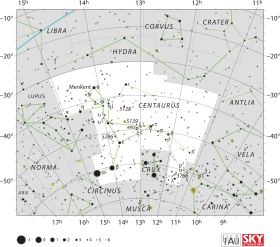Theta Centauri
| Observation data Epoch J2000.0 Equinox J2000.0 |
|
|---|---|
| Constellation | Centaurus |
| Right ascension | 14h 06m 40.94752s |
| Declination | –36° 22′ 11.8371″ |
| Apparent magnitude (V) | +2.06 |
| Characteristics | |
| Spectral type | K0 III |
| U−B color index | +0.90 |
| B−V color index | +0.99 |
| Astrometry | |
| Radial velocity (Rv) | +1.3 km/s |
| Proper motion (μ) |
RA: –520.53 mas/yr Dec.: –518.06 mas/yr |
| Parallax (π) | 55.45 ± 0.20mas |
| Distance | 58.8 ± 0.2 ly (18.03 ± 0.07 pc) |
| Absolute magnitude (MV) | 0.87 |
| Details | |
| Radius | 10.6 R☉ |
| Luminosity | 60 L☉ |
| Surface gravity (log g) | 2.75 cgs |
| Temperature | 4,980 K |
| Metallicity [Fe/H] | 0.03 dex |
| Other designations | |
| Database references | |
| SIMBAD | data |
Theta Centauri (θ Centauri, abbreviated Theta Cen, θ Cen), also named Menkent, is a star in the southern constellation of Centaurus, the centaur. With an apparent visual magnitude of +2.06, it is the fourth-brightest member of the constellation. Close enough so that its distance can be measured using the parallax technique, it is 58.8 light-years (18.0 parsecs) from the Sun.
This is an evolved giant star with a stellar classification of K0 III. The interferometry-measured angular diameter of this star, after correcting for limb darkening, is 5.46 ± 0.06 milliarcseconds, which, at its estimated distance, equates to a physical radius of about 10.6 times the radius of the Sun. The outer envelope has an effective temperature of 4,980 K, giving it the orange-hued glow of a cool, K-type star. Soft X-ray emission has been detected from this star, which has an estimated X-ray luminosity of 1.4 × 1027 erg s−1.
θ Centauri (Latinised to Theta Centauri) is the star's Bayer designation.
The traditional name Menkent is possibly an abbreviation of the Arabic ألمنكب ألقنتوس al mankib al-qanturis meaning "shoulder of the Centaur". In 2016, the International Astronomical Union organized a Working Group on Star Names (WGSN) to catalog and standardize proper names for stars. The WGSN approved the name Menkent for this star on 21 August 2016 and it is now so entered in the IAU Catalog of Star Names.
...
Wikipedia

